Hospitality Business Toolkit Report - Financial Performance and HR
VerifiedAdded on 2023/01/13
|13
|3027
|35
Report
AI Summary
This report analyzes key aspects of the hospitality business, encompassing financial performance management, human resource lifecycle stages, and legal compliance. It delves into principles of managing financial performance, including the use of KPIs, ROI, and double-entry bookkeeping for sales and purchase transactions. The report also examines the different stages of the HR life cycle, such as recruitment, onboarding, and exit strategies, along with performance management plans, training, and development. Furthermore, it highlights essential legislations within the hospitality industry, including the Equality Act, Health and Safety Work Act, and Minimum Wages Act, and how these impact decision-making processes. The report uses examples from Power Fit juice center and Marriott International to illustrate the practical application of these concepts.
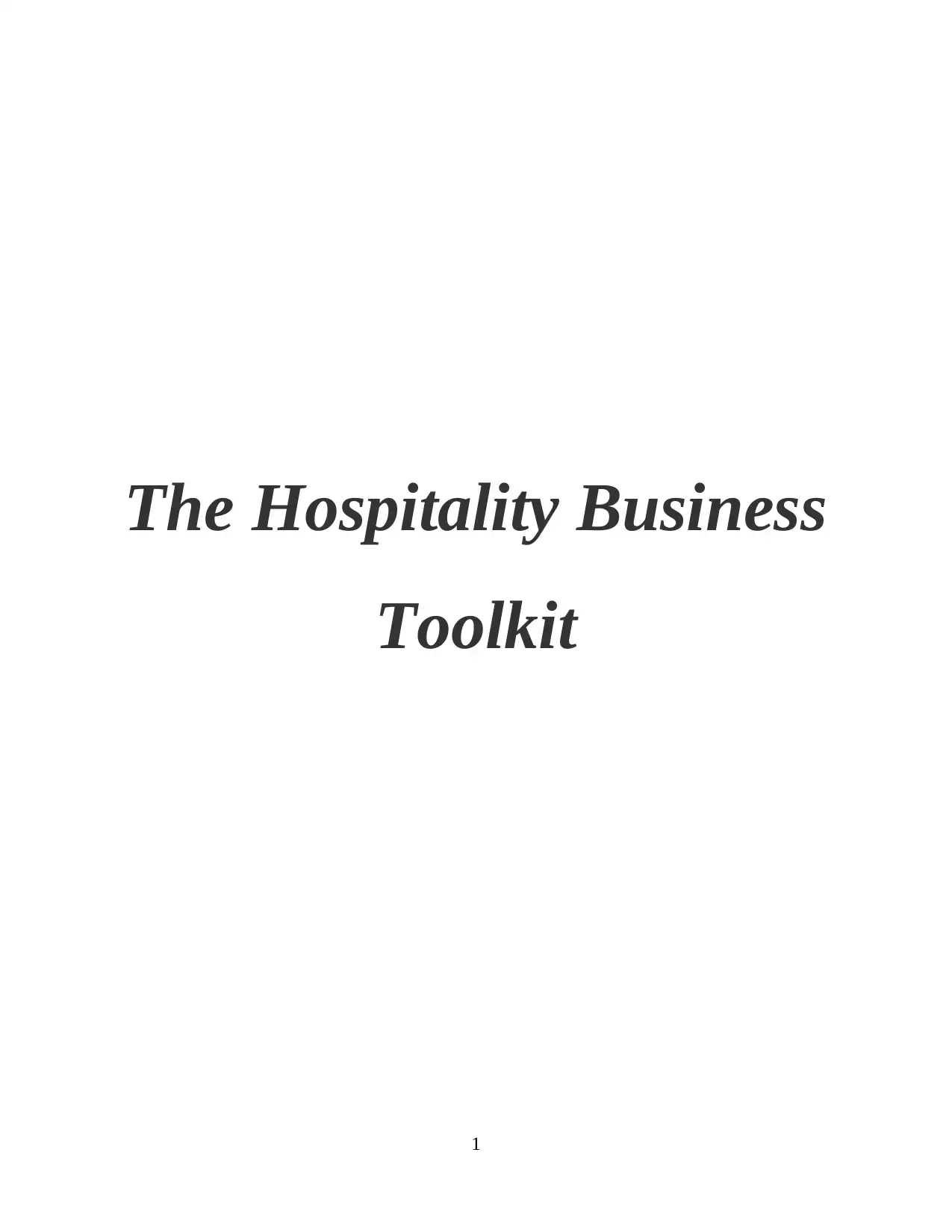
The Hospitality Business
Toolkit
1
Toolkit
1
Paraphrase This Document
Need a fresh take? Get an instant paraphrase of this document with our AI Paraphraser
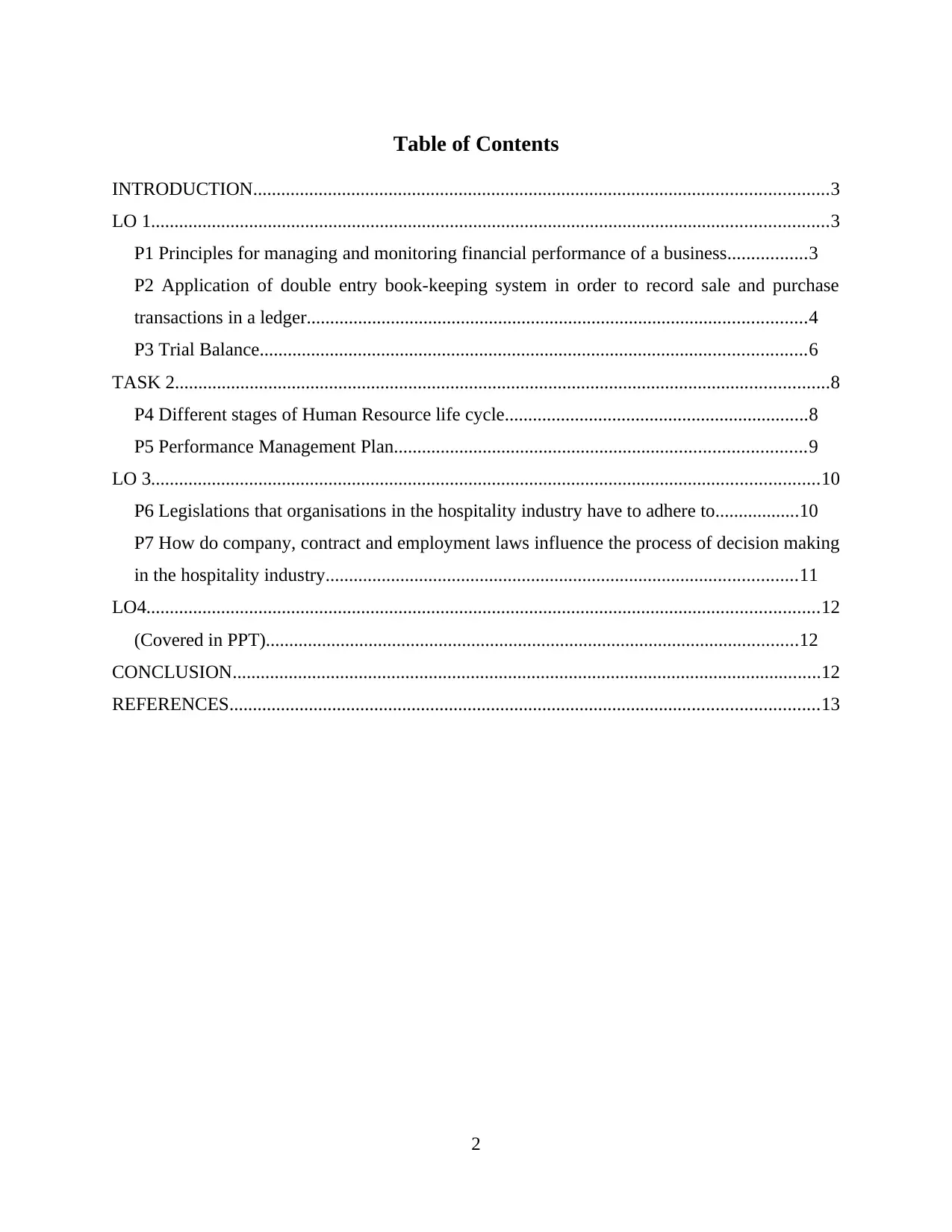
Table of Contents
INTRODUCTION...........................................................................................................................3
LO 1.................................................................................................................................................3
P1 Principles for managing and monitoring financial performance of a business.................3
P2 Application of double entry book-keeping system in order to record sale and purchase
transactions in a ledger...........................................................................................................4
P3 Trial Balance.....................................................................................................................6
TASK 2............................................................................................................................................8
P4 Different stages of Human Resource life cycle.................................................................8
P5 Performance Management Plan........................................................................................9
LO 3...............................................................................................................................................10
P6 Legislations that organisations in the hospitality industry have to adhere to..................10
P7 How do company, contract and employment laws influence the process of decision making
in the hospitality industry.....................................................................................................11
LO4................................................................................................................................................12
(Covered in PPT)..................................................................................................................12
CONCLUSION..............................................................................................................................12
REFERENCES..............................................................................................................................13
2
INTRODUCTION...........................................................................................................................3
LO 1.................................................................................................................................................3
P1 Principles for managing and monitoring financial performance of a business.................3
P2 Application of double entry book-keeping system in order to record sale and purchase
transactions in a ledger...........................................................................................................4
P3 Trial Balance.....................................................................................................................6
TASK 2............................................................................................................................................8
P4 Different stages of Human Resource life cycle.................................................................8
P5 Performance Management Plan........................................................................................9
LO 3...............................................................................................................................................10
P6 Legislations that organisations in the hospitality industry have to adhere to..................10
P7 How do company, contract and employment laws influence the process of decision making
in the hospitality industry.....................................................................................................11
LO4................................................................................................................................................12
(Covered in PPT)..................................................................................................................12
CONCLUSION..............................................................................................................................12
REFERENCES..............................................................................................................................13
2
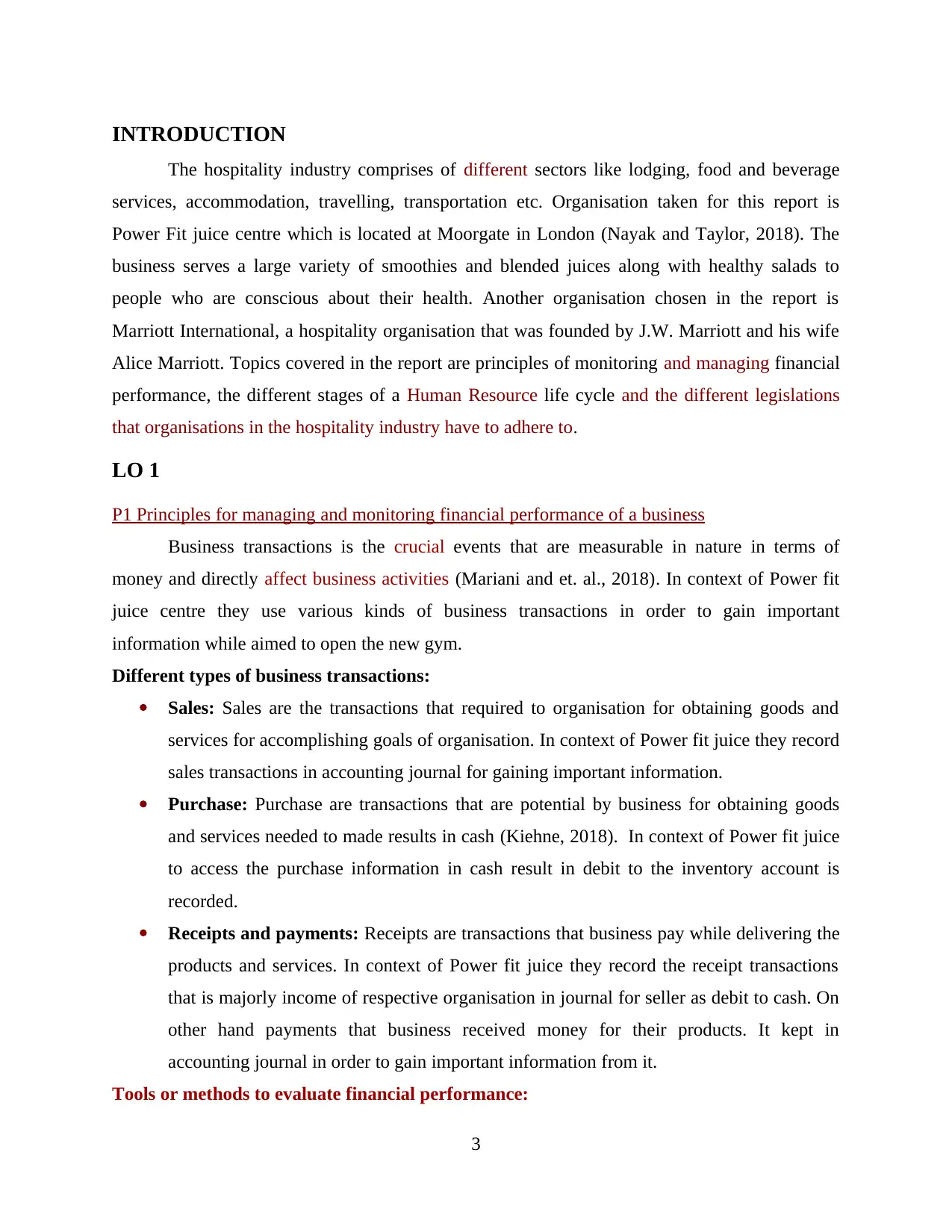
INTRODUCTION
The hospitality industry comprises of different sectors like lodging, food and beverage
services, accommodation, travelling, transportation etc. Organisation taken for this report is
Power Fit juice centre which is located at Moorgate in London (Nayak and Taylor, 2018). The
business serves a large variety of smoothies and blended juices along with healthy salads to
people who are conscious about their health. Another organisation chosen in the report is
Marriott International, a hospitality organisation that was founded by J.W. Marriott and his wife
Alice Marriott. Topics covered in the report are principles of monitoring and managing financial
performance, the different stages of a Human Resource life cycle and the different legislations
that organisations in the hospitality industry have to adhere to.
LO 1
P1 Principles for managing and monitoring financial performance of a business
Business transactions is the crucial events that are measurable in nature in terms of
money and directly affect business activities (Mariani and et. al., 2018). In context of Power fit
juice centre they use various kinds of business transactions in order to gain important
information while aimed to open the new gym.
Different types of business transactions:
Sales: Sales are the transactions that required to organisation for obtaining goods and
services for accomplishing goals of organisation. In context of Power fit juice they record
sales transactions in accounting journal for gaining important information.
Purchase: Purchase are transactions that are potential by business for obtaining goods
and services needed to made results in cash (Kiehne, 2018). In context of Power fit juice
to access the purchase information in cash result in debit to the inventory account is
recorded.
Receipts and payments: Receipts are transactions that business pay while delivering the
products and services. In context of Power fit juice they record the receipt transactions
that is majorly income of respective organisation in journal for seller as debit to cash. On
other hand payments that business received money for their products. It kept in
accounting journal in order to gain important information from it.
Tools or methods to evaluate financial performance:
3
The hospitality industry comprises of different sectors like lodging, food and beverage
services, accommodation, travelling, transportation etc. Organisation taken for this report is
Power Fit juice centre which is located at Moorgate in London (Nayak and Taylor, 2018). The
business serves a large variety of smoothies and blended juices along with healthy salads to
people who are conscious about their health. Another organisation chosen in the report is
Marriott International, a hospitality organisation that was founded by J.W. Marriott and his wife
Alice Marriott. Topics covered in the report are principles of monitoring and managing financial
performance, the different stages of a Human Resource life cycle and the different legislations
that organisations in the hospitality industry have to adhere to.
LO 1
P1 Principles for managing and monitoring financial performance of a business
Business transactions is the crucial events that are measurable in nature in terms of
money and directly affect business activities (Mariani and et. al., 2018). In context of Power fit
juice centre they use various kinds of business transactions in order to gain important
information while aimed to open the new gym.
Different types of business transactions:
Sales: Sales are the transactions that required to organisation for obtaining goods and
services for accomplishing goals of organisation. In context of Power fit juice they record
sales transactions in accounting journal for gaining important information.
Purchase: Purchase are transactions that are potential by business for obtaining goods
and services needed to made results in cash (Kiehne, 2018). In context of Power fit juice
to access the purchase information in cash result in debit to the inventory account is
recorded.
Receipts and payments: Receipts are transactions that business pay while delivering the
products and services. In context of Power fit juice they record the receipt transactions
that is majorly income of respective organisation in journal for seller as debit to cash. On
other hand payments that business received money for their products. It kept in
accounting journal in order to gain important information from it.
Tools or methods to evaluate financial performance:
3
⊘ This is a preview!⊘
Do you want full access?
Subscribe today to unlock all pages.

Trusted by 1+ million students worldwide

KPI: KPI is a measurable value provider tool which elaborates about the way an
organisation can achieving their business objectives (Jasnoff and Sheikh, 2019).
Organisations such as Power fit juice uses it at multiple level as it deals in many
businesses to measure their success factor by setting targets.
Return on investment: ROI helps to measure the profits or losses occurred by
organisation from their investments related to the money they invest in their business. In
context of Power fit juice they presently deals in the juice and aimed to expand their
business in Gym so it is very important for them to avail respective tool to measure their
return to carry out business activities potentially.
P2 Application of double entry book-keeping system in order to record sale and purchase
transactions in a ledger
The double entry book-keeping method of transactions states about that amount of business
transcribed in the nominal of two accounts. It states about that overall debit is equal to credit side
of balance.
4
organisation can achieving their business objectives (Jasnoff and Sheikh, 2019).
Organisations such as Power fit juice uses it at multiple level as it deals in many
businesses to measure their success factor by setting targets.
Return on investment: ROI helps to measure the profits or losses occurred by
organisation from their investments related to the money they invest in their business. In
context of Power fit juice they presently deals in the juice and aimed to expand their
business in Gym so it is very important for them to avail respective tool to measure their
return to carry out business activities potentially.
P2 Application of double entry book-keeping system in order to record sale and purchase
transactions in a ledger
The double entry book-keeping method of transactions states about that amount of business
transcribed in the nominal of two accounts. It states about that overall debit is equal to credit side
of balance.
4
Paraphrase This Document
Need a fresh take? Get an instant paraphrase of this document with our AI Paraphraser
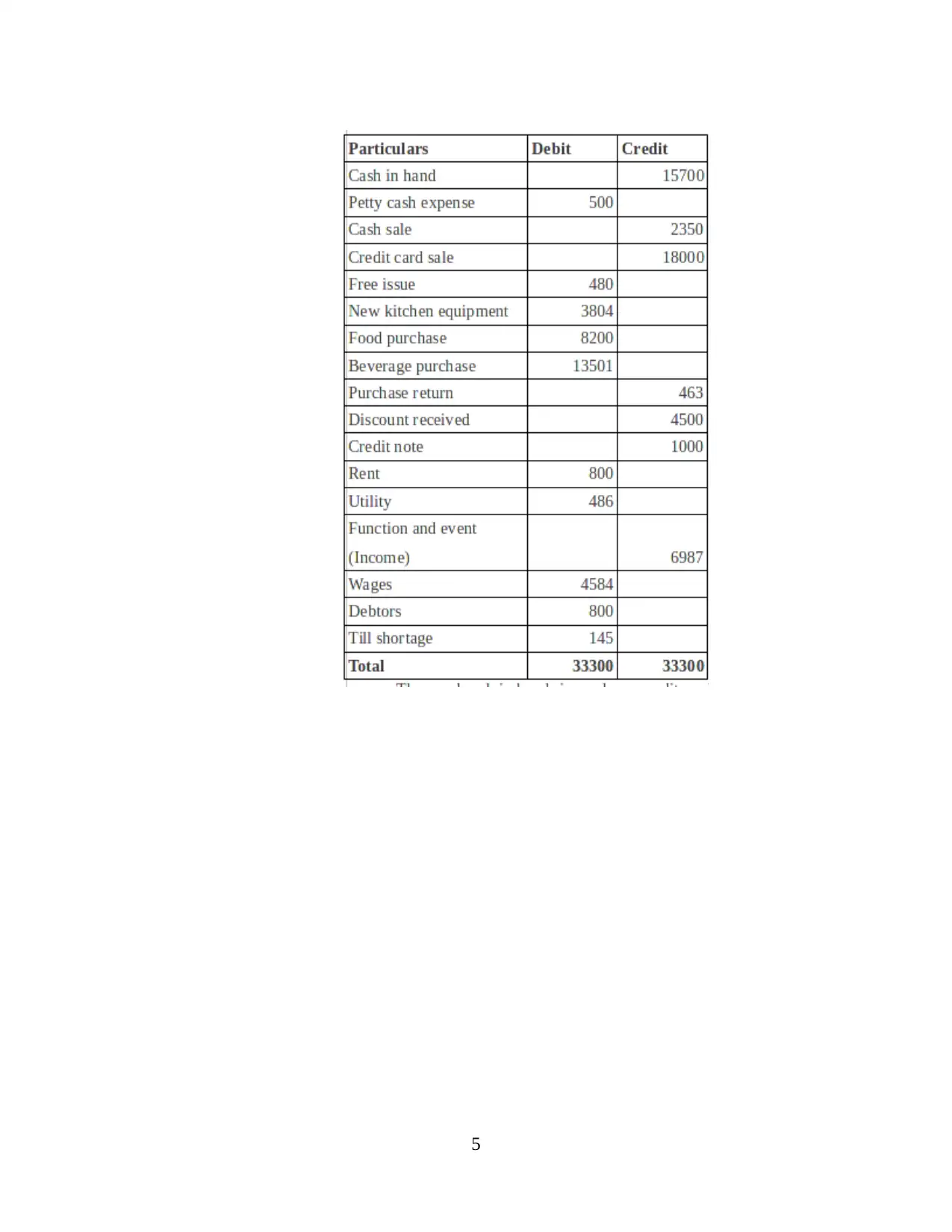
5
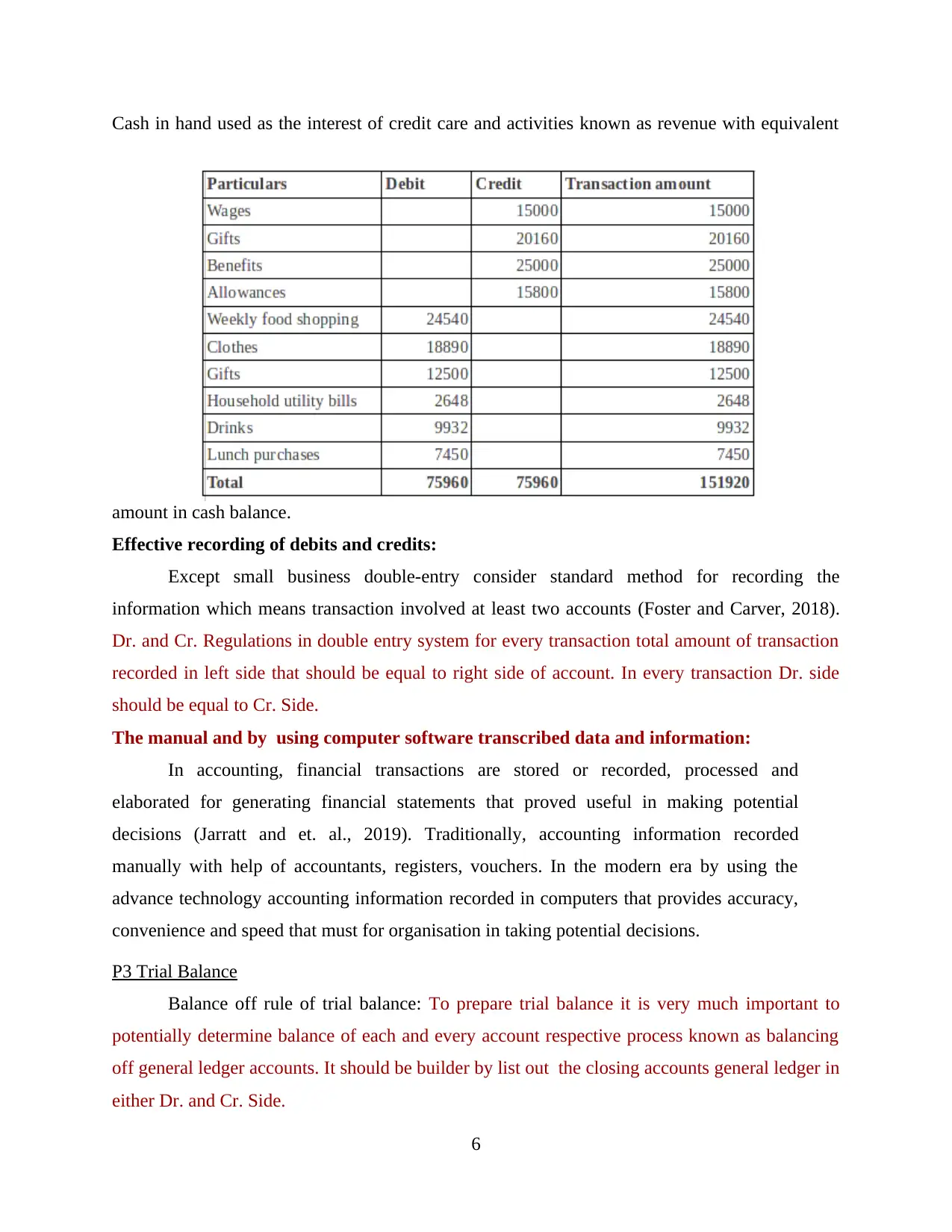
Cash in hand used as the interest of credit care and activities known as revenue with equivalent
amount in cash balance.
Effective recording of debits and credits:
Except small business double-entry consider standard method for recording the
information which means transaction involved at least two accounts (Foster and Carver, 2018).
Dr. and Cr. Regulations in double entry system for every transaction total amount of transaction
recorded in left side that should be equal to right side of account. In every transaction Dr. side
should be equal to Cr. Side.
The manual and by using computer software transcribed data and information:
In accounting, financial transactions are stored or recorded, processed and
elaborated for generating financial statements that proved useful in making potential
decisions (Jarratt and et. al., 2019). Traditionally, accounting information recorded
manually with help of accountants, registers, vouchers. In the modern era by using the
advance technology accounting information recorded in computers that provides accuracy,
convenience and speed that must for organisation in taking potential decisions.
P3 Trial Balance
Balance off rule of trial balance: To prepare trial balance it is very much important to
potentially determine balance of each and every account respective process known as balancing
off general ledger accounts. It should be builder by list out the closing accounts general ledger in
either Dr. and Cr. Side.
6
amount in cash balance.
Effective recording of debits and credits:
Except small business double-entry consider standard method for recording the
information which means transaction involved at least two accounts (Foster and Carver, 2018).
Dr. and Cr. Regulations in double entry system for every transaction total amount of transaction
recorded in left side that should be equal to right side of account. In every transaction Dr. side
should be equal to Cr. Side.
The manual and by using computer software transcribed data and information:
In accounting, financial transactions are stored or recorded, processed and
elaborated for generating financial statements that proved useful in making potential
decisions (Jarratt and et. al., 2019). Traditionally, accounting information recorded
manually with help of accountants, registers, vouchers. In the modern era by using the
advance technology accounting information recorded in computers that provides accuracy,
convenience and speed that must for organisation in taking potential decisions.
P3 Trial Balance
Balance off rule of trial balance: To prepare trial balance it is very much important to
potentially determine balance of each and every account respective process known as balancing
off general ledger accounts. It should be builder by list out the closing accounts general ledger in
either Dr. and Cr. Side.
6
⊘ This is a preview!⊘
Do you want full access?
Subscribe today to unlock all pages.

Trusted by 1+ million students worldwide
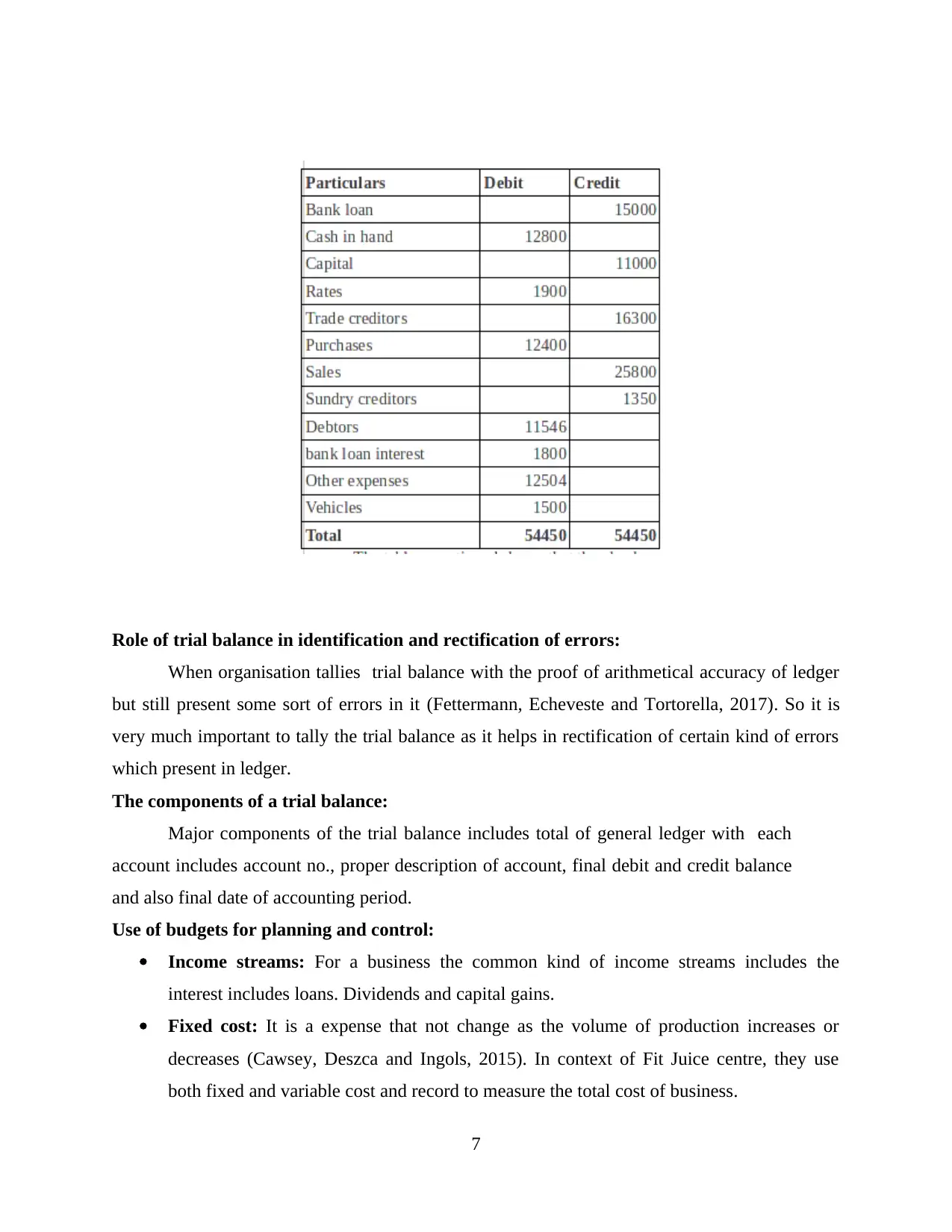
Role of trial balance in identification and rectification of errors:
When organisation tallies trial balance with the proof of arithmetical accuracy of ledger
but still present some sort of errors in it (Fettermann, Echeveste and Tortorella, 2017). So it is
very much important to tally the trial balance as it helps in rectification of certain kind of errors
which present in ledger.
The components of a trial balance:
Major components of the trial balance includes total of general ledger with each
account includes account no., proper description of account, final debit and credit balance
and also final date of accounting period.
Use of budgets for planning and control:
Income streams: For a business the common kind of income streams includes the
interest includes loans. Dividends and capital gains.
Fixed cost: It is a expense that not change as the volume of production increases or
decreases (Cawsey, Deszca and Ingols, 2015). In context of Fit Juice centre, they use
both fixed and variable cost and record to measure the total cost of business.
7
When organisation tallies trial balance with the proof of arithmetical accuracy of ledger
but still present some sort of errors in it (Fettermann, Echeveste and Tortorella, 2017). So it is
very much important to tally the trial balance as it helps in rectification of certain kind of errors
which present in ledger.
The components of a trial balance:
Major components of the trial balance includes total of general ledger with each
account includes account no., proper description of account, final debit and credit balance
and also final date of accounting period.
Use of budgets for planning and control:
Income streams: For a business the common kind of income streams includes the
interest includes loans. Dividends and capital gains.
Fixed cost: It is a expense that not change as the volume of production increases or
decreases (Cawsey, Deszca and Ingols, 2015). In context of Fit Juice centre, they use
both fixed and variable cost and record to measure the total cost of business.
7
Paraphrase This Document
Need a fresh take? Get an instant paraphrase of this document with our AI Paraphraser
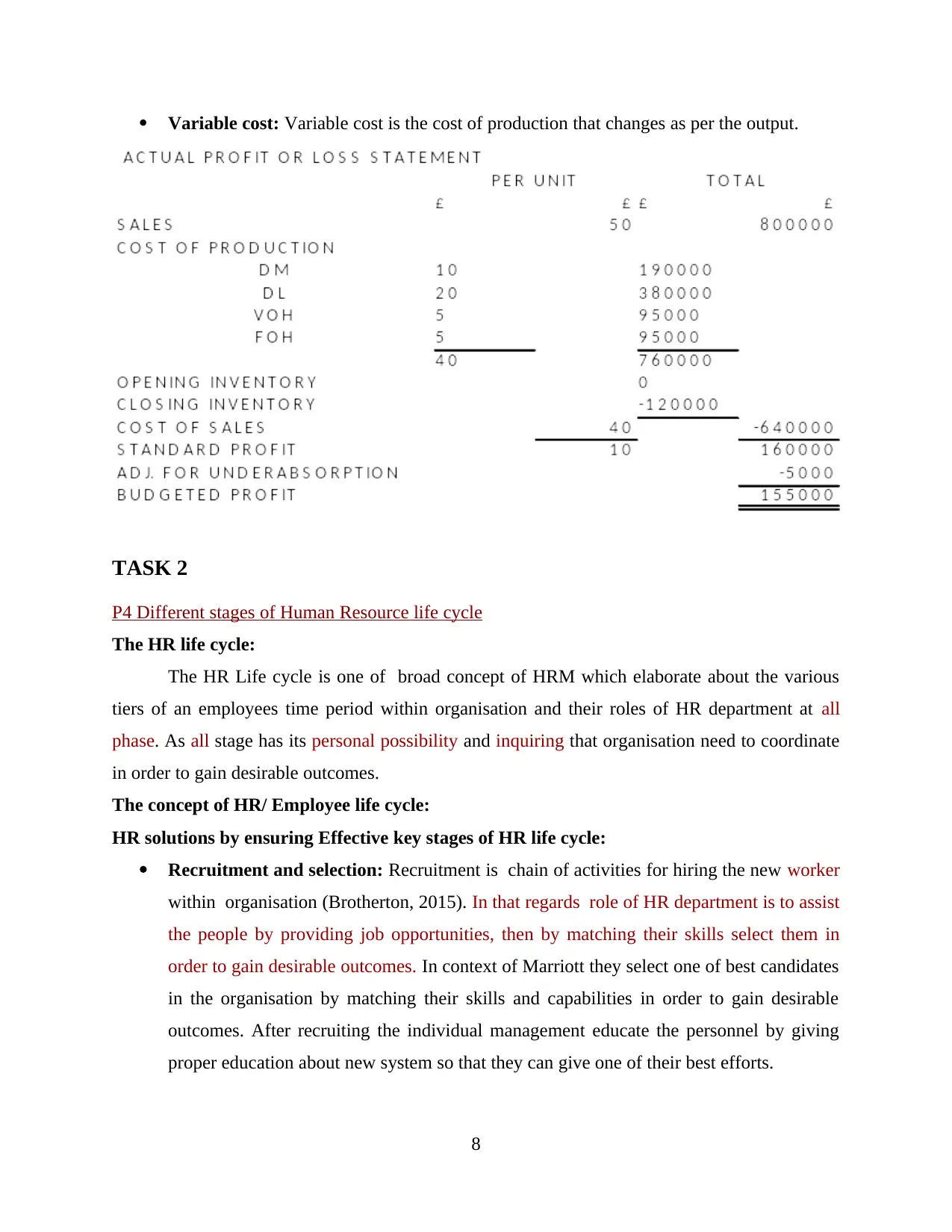
Variable cost: Variable cost is the cost of production that changes as per the output.
TASK 2
P4 Different stages of Human Resource life cycle
The HR life cycle:
The HR Life cycle is one of broad concept of HRM which elaborate about the various
tiers of an employees time period within organisation and their roles of HR department at all
phase. As all stage has its personal possibility and inquiring that organisation need to coordinate
in order to gain desirable outcomes.
The concept of HR/ Employee life cycle:
HR solutions by ensuring Effective key stages of HR life cycle:
Recruitment and selection: Recruitment is chain of activities for hiring the new worker
within organisation (Brotherton, 2015). In that regards role of HR department is to assist
the people by providing job opportunities, then by matching their skills select them in
order to gain desirable outcomes. In context of Marriott they select one of best candidates
in the organisation by matching their skills and capabilities in order to gain desirable
outcomes. After recruiting the individual management educate the personnel by giving
proper education about new system so that they can give one of their best efforts.
8
TASK 2
P4 Different stages of Human Resource life cycle
The HR life cycle:
The HR Life cycle is one of broad concept of HRM which elaborate about the various
tiers of an employees time period within organisation and their roles of HR department at all
phase. As all stage has its personal possibility and inquiring that organisation need to coordinate
in order to gain desirable outcomes.
The concept of HR/ Employee life cycle:
HR solutions by ensuring Effective key stages of HR life cycle:
Recruitment and selection: Recruitment is chain of activities for hiring the new worker
within organisation (Brotherton, 2015). In that regards role of HR department is to assist
the people by providing job opportunities, then by matching their skills select them in
order to gain desirable outcomes. In context of Marriott they select one of best candidates
in the organisation by matching their skills and capabilities in order to gain desirable
outcomes. After recruiting the individual management educate the personnel by giving
proper education about new system so that they can give one of their best efforts.
8
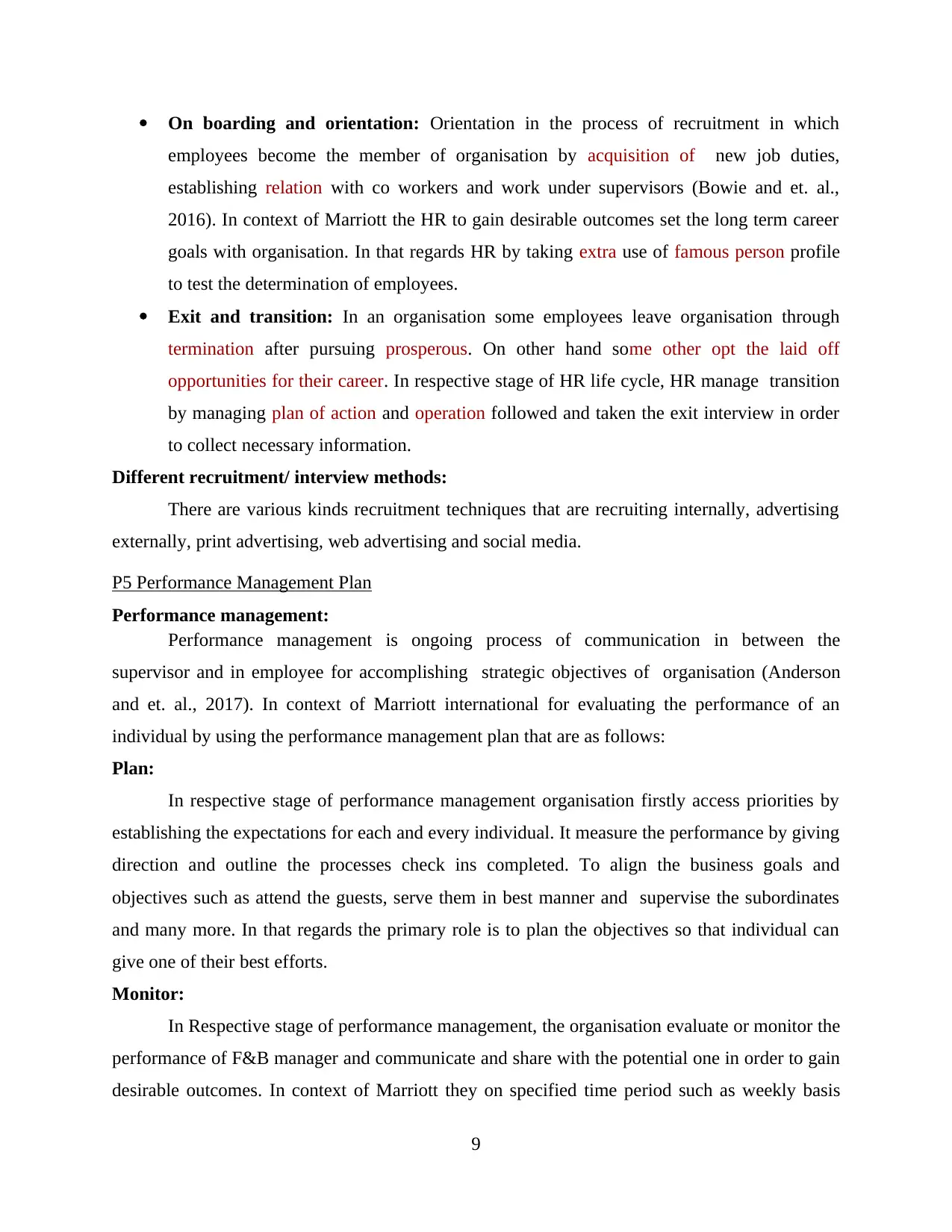
On boarding and orientation: Orientation in the process of recruitment in which
employees become the member of organisation by acquisition of new job duties,
establishing relation with co workers and work under supervisors (Bowie and et. al.,
2016). In context of Marriott the HR to gain desirable outcomes set the long term career
goals with organisation. In that regards HR by taking extra use of famous person profile
to test the determination of employees.
Exit and transition: In an organisation some employees leave organisation through
termination after pursuing prosperous. On other hand some other opt the laid off
opportunities for their career. In respective stage of HR life cycle, HR manage transition
by managing plan of action and operation followed and taken the exit interview in order
to collect necessary information.
Different recruitment/ interview methods:
There are various kinds recruitment techniques that are recruiting internally, advertising
externally, print advertising, web advertising and social media.
P5 Performance Management Plan
Performance management:
Performance management is ongoing process of communication in between the
supervisor and in employee for accomplishing strategic objectives of organisation (Anderson
and et. al., 2017). In context of Marriott international for evaluating the performance of an
individual by using the performance management plan that are as follows:
Plan:
In respective stage of performance management organisation firstly access priorities by
establishing the expectations for each and every individual. It measure the performance by giving
direction and outline the processes check ins completed. To align the business goals and
objectives such as attend the guests, serve them in best manner and supervise the subordinates
and many more. In that regards the primary role is to plan the objectives so that individual can
give one of their best efforts.
Monitor:
In Respective stage of performance management, the organisation evaluate or monitor the
performance of F&B manager and communicate and share with the potential one in order to gain
desirable outcomes. In context of Marriott they on specified time period such as weekly basis
9
employees become the member of organisation by acquisition of new job duties,
establishing relation with co workers and work under supervisors (Bowie and et. al.,
2016). In context of Marriott the HR to gain desirable outcomes set the long term career
goals with organisation. In that regards HR by taking extra use of famous person profile
to test the determination of employees.
Exit and transition: In an organisation some employees leave organisation through
termination after pursuing prosperous. On other hand some other opt the laid off
opportunities for their career. In respective stage of HR life cycle, HR manage transition
by managing plan of action and operation followed and taken the exit interview in order
to collect necessary information.
Different recruitment/ interview methods:
There are various kinds recruitment techniques that are recruiting internally, advertising
externally, print advertising, web advertising and social media.
P5 Performance Management Plan
Performance management:
Performance management is ongoing process of communication in between the
supervisor and in employee for accomplishing strategic objectives of organisation (Anderson
and et. al., 2017). In context of Marriott international for evaluating the performance of an
individual by using the performance management plan that are as follows:
Plan:
In respective stage of performance management organisation firstly access priorities by
establishing the expectations for each and every individual. It measure the performance by giving
direction and outline the processes check ins completed. To align the business goals and
objectives such as attend the guests, serve them in best manner and supervise the subordinates
and many more. In that regards the primary role is to plan the objectives so that individual can
give one of their best efforts.
Monitor:
In Respective stage of performance management, the organisation evaluate or monitor the
performance of F&B manager and communicate and share with the potential one in order to gain
desirable outcomes. In context of Marriott they on specified time period such as weekly basis
9
⊘ This is a preview!⊘
Do you want full access?
Subscribe today to unlock all pages.

Trusted by 1+ million students worldwide
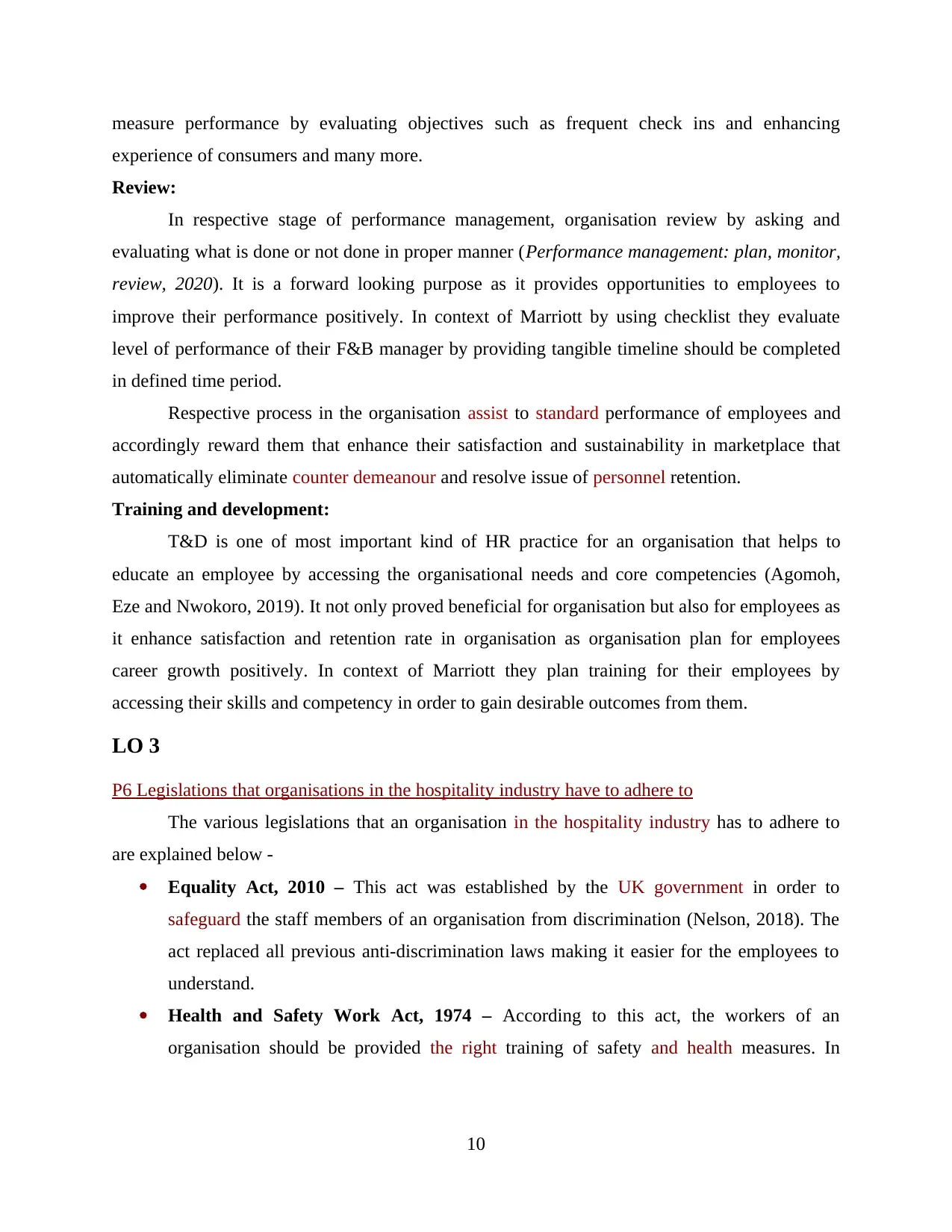
measure performance by evaluating objectives such as frequent check ins and enhancing
experience of consumers and many more.
Review:
In respective stage of performance management, organisation review by asking and
evaluating what is done or not done in proper manner (Performance management: plan, monitor,
review, 2020). It is a forward looking purpose as it provides opportunities to employees to
improve their performance positively. In context of Marriott by using checklist they evaluate
level of performance of their F&B manager by providing tangible timeline should be completed
in defined time period.
Respective process in the organisation assist to standard performance of employees and
accordingly reward them that enhance their satisfaction and sustainability in marketplace that
automatically eliminate counter demeanour and resolve issue of personnel retention.
Training and development:
T&D is one of most important kind of HR practice for an organisation that helps to
educate an employee by accessing the organisational needs and core competencies (Agomoh,
Eze and Nwokoro, 2019). It not only proved beneficial for organisation but also for employees as
it enhance satisfaction and retention rate in organisation as organisation plan for employees
career growth positively. In context of Marriott they plan training for their employees by
accessing their skills and competency in order to gain desirable outcomes from them.
LO 3
P6 Legislations that organisations in the hospitality industry have to adhere to
The various legislations that an organisation in the hospitality industry has to adhere to
are explained below -
Equality Act, 2010 – This act was established by the UK government in order to
safeguard the staff members of an organisation from discrimination (Nelson, 2018). The
act replaced all previous anti-discrimination laws making it easier for the employees to
understand.
Health and Safety Work Act, 1974 – According to this act, the workers of an
organisation should be provided the right training of safety and health measures. In
10
experience of consumers and many more.
Review:
In respective stage of performance management, organisation review by asking and
evaluating what is done or not done in proper manner (Performance management: plan, monitor,
review, 2020). It is a forward looking purpose as it provides opportunities to employees to
improve their performance positively. In context of Marriott by using checklist they evaluate
level of performance of their F&B manager by providing tangible timeline should be completed
in defined time period.
Respective process in the organisation assist to standard performance of employees and
accordingly reward them that enhance their satisfaction and sustainability in marketplace that
automatically eliminate counter demeanour and resolve issue of personnel retention.
Training and development:
T&D is one of most important kind of HR practice for an organisation that helps to
educate an employee by accessing the organisational needs and core competencies (Agomoh,
Eze and Nwokoro, 2019). It not only proved beneficial for organisation but also for employees as
it enhance satisfaction and retention rate in organisation as organisation plan for employees
career growth positively. In context of Marriott they plan training for their employees by
accessing their skills and competency in order to gain desirable outcomes from them.
LO 3
P6 Legislations that organisations in the hospitality industry have to adhere to
The various legislations that an organisation in the hospitality industry has to adhere to
are explained below -
Equality Act, 2010 – This act was established by the UK government in order to
safeguard the staff members of an organisation from discrimination (Nelson, 2018). The
act replaced all previous anti-discrimination laws making it easier for the employees to
understand.
Health and Safety Work Act, 1974 – According to this act, the workers of an
organisation should be provided the right training of safety and health measures. In
10
Paraphrase This Document
Need a fresh take? Get an instant paraphrase of this document with our AI Paraphraser
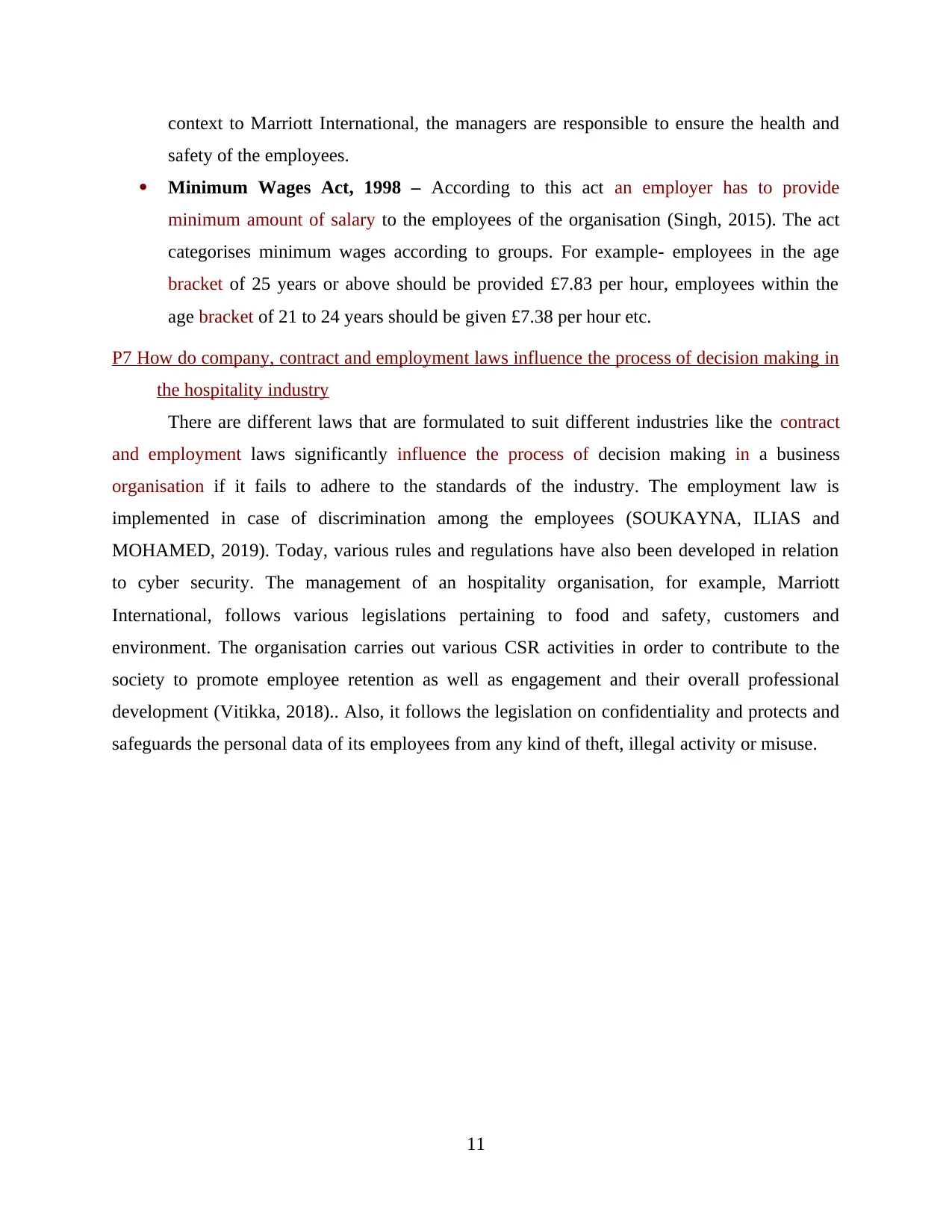
context to Marriott International, the managers are responsible to ensure the health and
safety of the employees.
Minimum Wages Act, 1998 – According to this act an employer has to provide
minimum amount of salary to the employees of the organisation (Singh, 2015). The act
categorises minimum wages according to groups. For example- employees in the age
bracket of 25 years or above should be provided £7.83 per hour, employees within the
age bracket of 21 to 24 years should be given £7.38 per hour etc.
P7 How do company, contract and employment laws influence the process of decision making in
the hospitality industry
There are different laws that are formulated to suit different industries like the contract
and employment laws significantly influence the process of decision making in a business
organisation if it fails to adhere to the standards of the industry. The employment law is
implemented in case of discrimination among the employees (SOUKAYNA, ILIAS and
MOHAMED, 2019). Today, various rules and regulations have also been developed in relation
to cyber security. The management of an hospitality organisation, for example, Marriott
International, follows various legislations pertaining to food and safety, customers and
environment. The organisation carries out various CSR activities in order to contribute to the
society to promote employee retention as well as engagement and their overall professional
development (Vitikka, 2018).. Also, it follows the legislation on confidentiality and protects and
safeguards the personal data of its employees from any kind of theft, illegal activity or misuse.
11
safety of the employees.
Minimum Wages Act, 1998 – According to this act an employer has to provide
minimum amount of salary to the employees of the organisation (Singh, 2015). The act
categorises minimum wages according to groups. For example- employees in the age
bracket of 25 years or above should be provided £7.83 per hour, employees within the
age bracket of 21 to 24 years should be given £7.38 per hour etc.
P7 How do company, contract and employment laws influence the process of decision making in
the hospitality industry
There are different laws that are formulated to suit different industries like the contract
and employment laws significantly influence the process of decision making in a business
organisation if it fails to adhere to the standards of the industry. The employment law is
implemented in case of discrimination among the employees (SOUKAYNA, ILIAS and
MOHAMED, 2019). Today, various rules and regulations have also been developed in relation
to cyber security. The management of an hospitality organisation, for example, Marriott
International, follows various legislations pertaining to food and safety, customers and
environment. The organisation carries out various CSR activities in order to contribute to the
society to promote employee retention as well as engagement and their overall professional
development (Vitikka, 2018).. Also, it follows the legislation on confidentiality and protects and
safeguards the personal data of its employees from any kind of theft, illegal activity or misuse.
11

LO4
(Covered in PPT)
CONCLUSION
The above report concludes that the hospitality industry is emerging as a fast growing
business. It comprises of different types of business transactions that are either made by the
customers or take place within the organisation. Also, there are various methods in which
candidates are recruited within a hospitality organisation and are provided with appropriate
training for the business to be successful. Therefore, if an organisation wants to run its operations
smoothly and be successful in the market, it should follow and adhere to various legislations and
legal responsibilities.
12
(Covered in PPT)
CONCLUSION
The above report concludes that the hospitality industry is emerging as a fast growing
business. It comprises of different types of business transactions that are either made by the
customers or take place within the organisation. Also, there are various methods in which
candidates are recruited within a hospitality organisation and are provided with appropriate
training for the business to be successful. Therefore, if an organisation wants to run its operations
smoothly and be successful in the market, it should follow and adhere to various legislations and
legal responsibilities.
12
⊘ This is a preview!⊘
Do you want full access?
Subscribe today to unlock all pages.

Trusted by 1+ million students worldwide
1 out of 13
Related Documents
Your All-in-One AI-Powered Toolkit for Academic Success.
+13062052269
info@desklib.com
Available 24*7 on WhatsApp / Email
![[object Object]](/_next/static/media/star-bottom.7253800d.svg)
Unlock your academic potential
Copyright © 2020–2025 A2Z Services. All Rights Reserved. Developed and managed by ZUCOL.




